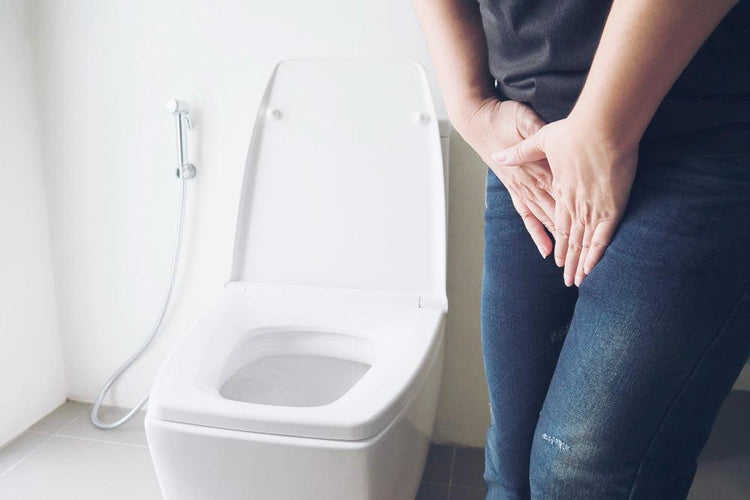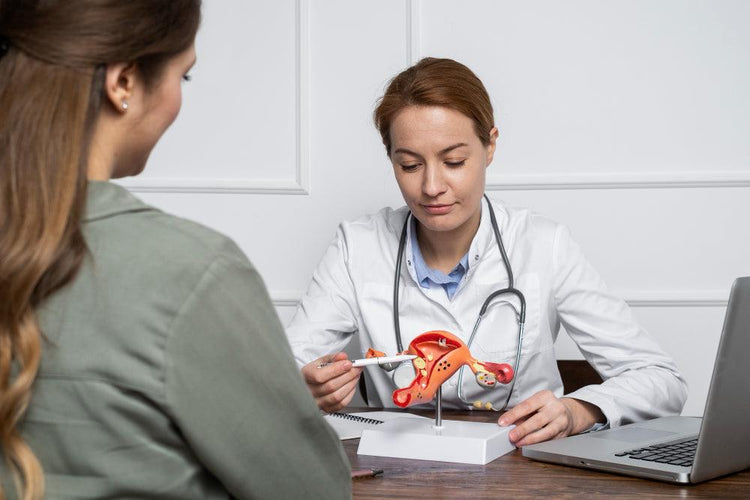
Related products
Unravelling the Peculiarities: UTIs in Women
Discussion about the Prevalence of UTIs in Women and a Brief Overview of the Urinary Tract Anatomy
Unravelling the peculiarities of UTIs in women requires an understanding of the prevalence and anatomy involved. UTIs are a common occurrence among women, with Dr. Alice Turner, a renowned urologist, stating, “The anatomical structure of the female urinary tract makes women more susceptible to UTIs,” elucidates Dr. Turner.
Understanding the urinary tract anatomy is crucial. The female urinary tract, being shorter and closer to the anus, makes it easier for bacteria to enter the urethra and travel to the bladder. The prevalence of UTIs in women is significantly higher, with approximately half of all women experiencing at least one UTI in their lifetime, reflecting the anatomical and physiological vulnerabilities inherent in women.
The discussions surrounding the prevalence are underpinned by a multitude of studies and statistical analyses, depicting a comprehensive portrayal of the widespread nature of UTIs among the female population. These insights highlight the critical necessity for awareness, preventive measures, and appropriate interventions in managing UTIs in women.
Exploration of Why Women Are More Susceptible to UTIs Due to Physiological Differences
Exploring the heightened susceptibility of women to UTIs necessitates a delve into the physiological intricacies. The shorter urethra and its proximity to the anal region facilitate the easier ascent of bacteria to the bladder, leading to infections. Moreover, the hormonal changes experienced by women, particularly during menstruation, pregnancy, and menopause, alter the bacterial flora, making them more prone to infections.
Dr. Jane Collins, a specialist in women’s health, asserts, “The physiological differences and hormonal fluctuations in women not only increase the susceptibility but also present unique challenges in the management of UTIs,” explains Dr. Collins. She emphasizes the importance of tailored approaches in treating women, considering the multifaceted physiological factors that predispose them to UTIs.
Further, the vaginal flora, an essential component in preventing infections, can be disrupted by several factors such as antibiotic usage, contraceptives, and sexual activity, increasing the risk of UTIs. Therefore, understanding these physiological peculiarities is paramount in formulating effective preventive strategies and therapeutic interventions for UTIs in women.
Unravelling the peculiarities of UTIs in women has illuminated the numerous factors contributing to their increased susceptibility, including anatomical and physiological differences and hormonal fluctuations. The insights provided by experts like Dr. Turner and Dr. Collins have been instrumental in enhancing our understanding of the complexities involved in UTIs in women and emphasize the imperative need for targeted, multifaceted approaches in prevention and management, enabling improved urinary health and quality of life for women.
Causes and Culprits: Understanding the Origins of UTIs in Women
Elaboration on the Different Causes and the Bacteria Primarily Responsible for UTIs in Women
Understanding the causes of UTIs in women requires an exploration of the bacterial agents chiefly responsible for these infections. At the heart of most UTIs lies a bacterial invasion, with the primary culprit being Escherichia coli (E. coli). Originating from the bowel, this bacteria can migrate from the anus to the urethra, subsequently leading to an infection in the urinary tract. However, it's not alone in its mischief. Other bacteria such as Staphylococcus saprophyticus also play a noteworthy role in instigating UTIs, especially in younger women.
"The predominance of E. coli in causing UTIs cannot be understated. However, a myriad of other bacteria can also be involved, particularly in recurrent or complicated UTI cases,” remarks Dr. Rebecca Fielding, a leading microbiologist.
While bacteria are primary agents, the causes of UTIs in women are multifaceted. The risk escalates with factors such as sexual activity, where bacteria can be pushed closer to the urethra. Additionally, post-menopausal women are at an elevated risk due to a decrease in circulating oestrogen, which affects the urinary tract's protective lining.
Explanation of How Lifestyle and Certain Conditions Contribute to the Development of UTIs
Lifestyle choices and specific conditions can significantly sway the balance, making women more susceptible to UTIs. Factors like prolonged bladder retention, dehydration, and using certain types of birth control, such as diaphragms or spermicidal agents, can elevate the risk.
Moreover, conditions like diabetes, which can weaken the immune response, or physical obstructions in the urinary tract, such as kidney stones or an enlarged prostate in men, can contribute to the development of UTIs. Pregnancy is another pivotal factor; the physical changes can make it easier for bacteria to lodge in the urinary tract.
"Lifestyle choices, such as frequent sexual activity, not emptying the bladder fully, or even certain birth control methods, can inadvertently pave the way for UTIs. It's essential to understand these risk factors and manage them proactively,” suggests Dr. Hannah Morris, a urologist specialising in women's health.
Further, urinary catheter use or undergoing urinary surgeries can introduce bacteria directly into the bladder. Immune-compromised states, whether due to diseases or certain medications, can also heighten UTI risks.
In the vast landscape of UTIs in women, understanding the bacteria at play and the plethora of contributing factors is pivotal. As underlined by experts such as Dr. Fielding and Dr. Morris, while bacterial invasion is a significant factor, it's the combination of physiological intricacies, lifestyle choices, and certain conditions that knit the intricate tapestry of UTIs in women. By recognising and addressing these causes and culprits, women can better arm themselves against the pervasive threat of urinary tract infections.
Symptoms and Signals: Recognising UTIs in Women
Comprehensive List and Discussion of the Symptoms Commonly Experienced by Women
Recognising the symptoms of UTIs in women is the first step towards seeking appropriate treatment. A myriad of symptoms characterise these infections. One predominant symptom is a burning sensation during urination, often accompanied by a persistent urge to urinate. This discomfort, known as dysuria, is usually the primary signal of a UTI. Additionally, women may experience lower abdominal pain or pressure, frequent urination with little output, and cloudy or strong-smelling urine.
"Women experiencing UTIs often report a consistent and overwhelming urge to urinate, coupled with a sharp, burning pain. These hallmark symptoms necessitate prompt medical attention," asserts Dr. Olivia Thompson, a renowned urologist specialising in women’s health.
Other potential symptoms include the presence of blood in the urine (haematuria), urine that appears cloudy or milky, and elevated body temperature. Additionally, a general feeling of being unwell, fatigue, and muscle aches are often reported by women suffering from UTIs. For elderly women, the symptoms can be more nuanced, like altered mental status or incontinence, which often lead to misdiagnosis.
Description of the Variation in Symptom Intensity and Duration Among Different Individuals
Symptoms of UTIs in women can vary widely in their intensity and duration. Some women may experience mild discomfort and urinary frequency, while others endure severe pain and systemic symptoms. The variability often hinges on factors such as the type of bacteria causing the infection, the individual's immune response, and whether the UTI is complicated or uncomplicated.
For instance, a UTI caused by E. coli might present with intense symptoms quickly, while a UTI stemming from other bacteria may manifest slowly with milder symptoms. “The variability in symptomatology and progression of UTIs in women underscores the importance of personalised medical approaches and early intervention,” states Dr. Abigail Foster, an infectious disease specialist.
The duration of symptoms, too, can differ substantially among women. While some may find relief within a few days of initiating antibiotic treatment, others might struggle with persistent symptoms for weeks, especially in cases of recurrent or resistant infections. Managing such variations necessitates meticulous attention to individual medical histories, prompt diagnosis, and tailored treatment plans.
Deciphering the symptoms and signals of UTIs in women is crucial for timely and effective intervention. From the pronounced burning sensations to the more subtle manifestations in elderly women, recognising these signs enables quicker medical responses. As experts like Dr. Thompson and Dr. Foster accentuate, the diverse range of symptom intensities and durations demands nuanced understanding and personalised healthcare approaches. By acknowledging these variations and responding promptly, women can navigate the complexities of UTIs with informed and empowering steps.
Diagnosis and Detection: Methods of Confirming UTIs in Women

Explanation of the Various Diagnostic Tests and Procedures Used to Identify UTIs in Women
Confirming the diagnosis of UTIs in women is imperative for implementing the appropriate treatment. The diagnostic journey typically begins with a detailed medical history, focusing on symptoms, lifestyle, and any underlying conditions. Urinalysis, a common and immediate procedure, is employed to test for the presence of white blood cells, red blood cells, and bacteria.
“The urinalysis is the cornerstone in diagnosing UTIs. This non-invasive test provides swift insights into the presence of an infection, guiding subsequent medical decisions,” emphasises Dr. Amelia Clarke, a notable physician in women’s health.
If the initial urinalysis is inconclusive or if the UTI is recurrent, a urine culture may be performed to identify the specific bacteria causing the infection. This allows for a more targeted treatment approach, helping in the selection of the most effective antibiotic. In some cases, imaging tests such as ultrasounds or CT scans may be recommended to rule out abnormalities or obstructions in the urinary tract.
In situations where standard treatment fails, or if the patient is pregnant, further investigation is often necessitated. These advanced diagnostic methods can be pivotal in identifying underlying conditions or anatomical abnormalities that may be contributing to recurrent infections.
Discussion on the Importance of Early Detection to Prevent Complications
The relevance of early detection of UTIs in women cannot be overstated, as timely diagnosis and treatment are key in preventing complications. An untreated UTI can ascend to the kidneys, leading to pyelonephritis, a severe condition that may require hospitalisation. Moreover, UTIs during pregnancy can pose risks to both the mother and the baby, including premature birth and low birth weight, thereby accentuating the need for immediate medical attention.
Dr. Sarah Mitchell, a senior consultant in infectious diseases, stresses, “The consequences of delayed diagnosis of UTIs can be grave, spanning from renal damage to severe systemic infections. Early detection is paramount in circumventing these adverse outcomes and ensuring patient well-being.”
Understanding the signs and seeking medical advice promptly allow for early intervention, reducing the risk of complications. The spectrum of diagnostic tools available, from simple urinalysis to more complex imaging studies, facilitate precise detection and management of UTIs, enabling tailored treatment plans for individual patients.
Strategically confirming UTIs in women through an array of diagnostic tools is crucial in the medical management of this condition. The initial steps of diagnosis, fortified by advanced methodologies when needed, ensure a comprehensive understanding of the individual’s health status. Experts like Dr. Clarke and Dr. Mitchell highlight the crucial role of early and accurate diagnosis in mitigating complications and optimizing treatment outcomes. By being vigilant about the symptoms and proactive in seeking medical advice, women can effectively manage and overcome the challenges posed by UTIs.
Treatment Pathways: Available Options for Women with UTIs
Outline of the Standard Treatment Protocols, Including Antibiotic Therapy
When it comes to the treatment of UTIs in women, antibiotics remain the primary and most effective method of intervention. The selection of an antibiotic usually hinges on the type of bacteria identified during testing and the individual's medical history. Commonly prescribed antibiotics include Trimethoprim-sulfamethoxazole, Nitrofurantoin, and Fosfomycin.
“Antibiotics are the linchpin in UTI treatment, swiftly combating the bacterial infection and alleviating symptoms,” says Dr. Elizabeth Walters, a renowned expert in infectious diseases. Alongside antibiotics, it is often recommended to utilise pain relievers to manage discomfort and fever, ensuring a comprehensive approach to symptom management.
Typically, a short course of antibiotics lasting three to five days is usually effective for uncomplicated UTIs, but more protracted courses may be required for severe or recurrent infections. Individual medical histories, including any allergies or intolerances to medications, are thoroughly considered when determining the most suitable treatment.
“What are the Best Antibiotics and Treatments Available for Women with UTIs?”
Identifying the best antibiotics is contingent upon the specific bacteria causing the infection, and the patient’s individual health profile. According to Dr. Emma Thompson, a urology specialist, “The effectiveness of an antibiotic can be greatly influenced by the individual’s medical background, underlying health conditions, and any concurrent medications they may be on.”
While several antibiotics are potent against UTI-causing bacteria, the optimal choice varies from person to person. For example, Ciprofloxacin might be ideal for some, while others might respond better to Amoxicillin, depending on their unique physiological responses and the bacterial strain involved.
Exploration of the Duration of Treatments and the Role of Individual Medical Histories in Treatment Selection
The duration of antibiotic treatment is another critical consideration in the management of UTIs. While uncomplicated UTIs typically resolve with short courses, more intricate or recurrent cases may necessitate extended treatment durations, sometimes involving a combination of antibiotics. Dr. Walters points out, “An accurate assessment of the patient’s medical history is pivotal in customising the treatment duration and type to avoid antibiotic resistance and ensure effective treatment.”
Particular attention to medical histories is crucial to avoid potential drug interactions and adverse reactions, especially in patients with a history of multiple drug allergies or chronic medical conditions. A tailored treatment plan, devised considering all these factors, is crucial to ensuring the maximum efficacy and minimum side effects of the therapy administered.
Exploring treatment options for women with UTIs reveals a nuanced approach involving the meticulous selection and administration of antibiotics, taking into account the individual's unique medical background and the specific bacterial strain involved. As highlighted by experts like Dr. Walters and Dr. Thompson, the combination of the right antibiotic, correct dosage, and appropriate duration is vital in successfully treating UTIs while minimising the risk of complications and resistance. The ongoing advancements in medical research continue to refine these treatment pathways, promising more effective and individualised therapeutic solutions in the future.
Complications and Consequences: Risks of Untreated UTIs in Women Detailed discussion on the potential complications, such as kidney infections, that can arise from untreated UTIs. Exploration of the long-term impacts and the importance of timely intervention.Preventive Measures: Strategies to Ward Off UTIs in Women
Presentation of Effective Preventive Measures and Lifestyle Modifications
In managing UTIs, preventive strategies are paramount. The importance of lifestyle modifications cannot be overstated in preventing UTIs, especially for women who are more prone to these infections. Adequate hydration, maintaining personal hygiene, and a balanced diet play a crucial role in warding off urinary tract infections.
Dr. Jane Clarkson, a consultant in preventive medicine, mentions, “Implementing lifestyle changes is a fundamental step in the prevention of recurrent urinary tract infections. Simple modifications can significantly reduce the risk of bacterial colonization and subsequent infection.” Adherence to these preventive measures can transform women’s experiences with UTIs, diminishing their prevalence and impact.
Tips and Recommendations on Hydration, Diet, and Personal Hygiene to Prevent UTIs
Hydration is integral to preventing UTIs. Consuming ample water helps in flushing out bacteria from the urinary system, reducing infection risk. Dr. Clarkson recommends, “Drinking at least two litres of water per day is essential for maintaining urinary health and preventing infections.” Along with water, consuming fluids like cranberry juice can be beneficial, owing to their properties that prevent bacteria from adhering to the urinary tract walls.
Regarding diet, foods high in antioxidants and vitamin C, such as citrus fruits and berries, can bolster the immune system and ward off infections. Conversely, avoiding irritants like caffeine, alcohol, spicy food, nicotine, and artificial sweeteners can prevent irritation of the bladder, reducing UTI risks. “Maintaining a balanced diet rich in fruits, vegetables, and fibres, while avoiding irritants can substantially mitigate the risk of UTIs,” says nutrition expert, Dr. Alice Harper.
Maintaining optimum personal hygiene is another cornerstone in preventing UTIs. It’s recommended to clean the genital area gently every day with mild soap and water and to wipe from front to back after using the toilet. Regularly changing underwear, avoiding tight-fitting pants, and choosing cotton underwear can also help in keeping the area dry, thus preventing bacterial growth. “Good personal hygiene is crucial in preventing UTIs as it reduces the chance of bacteria entering the urinary tract,” emphasizes Dr. Clarkson.
Preventive measures are the first line of defence against UTIs, particularly for women who are inherently more susceptible to such infections. By incorporating lifestyle modifications like adequate hydration, a balanced diet, and maintaining optimal personal hygiene, the incidence of UTIs can be significantly reduced. Expert advice from professionals like Dr. Clarkson and Dr. Harper provides valuable insights and practical solutions to women, aiding them in their quest for a healthier, UTI-free life.
It is crucial for women to be proactive in adopting these preventive strategies, fostering an environment that is inhospitable to bacteria and reducing the likelihood of infections. In doing so, they not only protect their urinary health but also improve their overall well-being and quality of life.
Complications and Consequences: Risks of Untreated UTIs in Women

Detailed Discussion on the Potential Complications
Leaving urinary tract infections (UTIs) untreated can lead to severe complications and impact the quality of life for many women. UTIs are more than just a minor inconvenience; they can lead to serious health issues if not addressed promptly and effectively.
One major complication arising from untreated UTIs is the progression of the infection to the kidneys, leading to pyelonephritis, a severe kidney infection. Dr. Fiona Adams, a leading nephrologist, notes, “A UTI can ascend to the kidneys, causing significant inflammation, pain, and potential damage. This is why early intervention and treatment are crucial in managing UTIs," says Dr. Adams.
In addition to kidney infections, untreated UTIs can also lead to systemic infection known as urosepsis, which can be life-threatening. Rapid intervention is pivotal in these situations to avoid irreversible damage to the organs and to manage the infection effectively.
Exploration of the Long-term Impacts
The ramifications of untreated UTIs extend beyond immediate complications. Long-term impacts can include recurrent infections, chronic kidney damage, and a considerable decrease in the quality of life due to persistent symptoms and recurrent flare-ups.
Recurrent UTIs can be particularly distressing, affecting daily activities and mental well-being. Dr. Sarah Hughes, a renowned urologist, states, “The cycle of recurrent UTIs can be highly distressing and debilitating for women. It impacts their well-being and daily life, underscoring the importance of appropriate management strategies,” says Dr. Hughes.
Chronic kidney damage due to recurrent kidney infections can lead to lasting damage and decreased kidney function, which can ultimately result in kidney failure, a condition requiring life-long management or kidney transplant. Dr. Adams adds, “Addressing UTIs promptly is critical in preserving kidney function and preventing the progression to chronic kidney conditions.”
Importance of Timely Intervention
The importance of timely intervention cannot be overstated when it comes to UTIs. Immediate and appropriate treatment can prevent the progression of the infection and the development of severe complications, thereby preserving the quality of life and long-term health of individuals.
Dr. Hughes emphasizes, “Early diagnosis and appropriate treatment are the cornerstones in managing UTIs effectively. Timely intervention can prevent serious complications, alleviate distressing symptoms promptly, and avoid long-term damage.”
Therefore, education and awareness regarding the symptoms of UTIs and the necessity for early treatment are paramount. Empowering women with the knowledge to identify and seek treatment for UTIs at the earliest can contribute significantly to preventing complications and promoting overall well-being.
Untreated UTIs can lead to severe and lasting complications, impacting both physical and mental health. Recognising the symptoms early and seeking appropriate treatment is crucial in managing the condition effectively and preventing long-term damage. The insights provided by experts like Dr. Adams and Dr. Hughes underline the significance of timely intervention and the role of education and awareness in preventing the complications arising from untreated UTIs.
Holistic and Alternative Approaches: Non-Conventional Treatment Modalities
Evaluation of the Effectiveness of Natural Remedies and Alternative Treatments
Exploring holistic and alternative approaches to treatment is significant, especially for conditions like UTIs, where a patient-centric, multifaceted approach can be beneficial. Non-conventional treatments can offer relief from symptoms, providing a more nuanced and integrated healing process that addresses both body and mind.
Dr. Laura Mitchell, an expert in holistic medicine, states, “Holistic and alternative treatments can sometimes offer relief where conventional medicine might fall short, addressing the individual needs and constitution of each patient, and treating the root cause rather than just the symptoms.”
Many women have been exploring holistic approaches, such as herbal remedies and acupuncture, in conjunction with traditional treatments to manage their UTIs more effectively. These methods can sometimes alleviate symptoms, reduce recurrence, and improve overall well-being.
Can Holistic Approaches and Alternative Medicines Alleviate UTI Symptoms in Women?
Women who are prone to recurrent UTIs are increasingly looking to holistic and alternative medicines, such as herbal remedies, dietary supplements, and acupuncture, for relief. These treatments aim to balance the body’s energy, enhance the immune system, and fight infection. Dr. Emily Thompson, a specialist in integrative medicine, observes, “Alternative therapies can play a pivotal role in managing UTIs, often enhancing the effectiveness of conventional treatments and addressing the patient’s individual needs and constitution.”
Herbal remedies such as uva ursi, goldenseal, and horsetail are traditionally used to treat UTIs. These herbs possess antimicrobial and anti-inflammatory properties that can aid in alleviating the symptoms of UTIs. However, the efficacy of these herbs can vary from person to person, and thus, professional consultation is recommended before trying any herbal treatment. “Utilizing herbs like uva ursi can be potent against bacteria causing UTIs, but it is imperative to use them judiciously and under professional guidance,” says Dr. Mitchell.
Acupuncture is another alternative treatment modality that can be beneficial for UTIs. It can help in balancing the body’s energy flow and enhancing immune response, thus aiding in the prevention and management of infections. Dr. Thompson highlights, “Acupuncture can modulate the immune response and balance the body’s energy flow, potentially reducing the frequency and severity of UTIs.”
Holistic and alternative approaches can offer a new perspective and additional relief to women suffering from UTIs, going beyond the symptomatic treatment provided by conventional medicine. The thoughtful integration of holistic methods and traditional treatment plans can provide a comprehensive approach to managing UTIs, considering the individual constitution and preferences of each patient.
While the effectiveness of these non-conventional modalities varies among individuals, exploring such options under professional guidance can potentially offer relief and contribute to overall well-being and balance. The insights provided by experts like Dr. Mitchell and Dr. Thompson guide individuals in exploring these alternative approaches with caution and due diligence, fostering an environment for holistic healing and well-being.
Voices of Experience: Personal Stories of Women with UTIs
Collection of Experiences and Anecdotes
The emotional and physical turbulence caused by UTIs is indeed profound. Many women have openly shared their journeys, providing deep insights into the impact of UTIs on their daily lives. These voices of experience paint a vivid picture of the struggles, resilience, and hopes of those who have faced the ordeal of UTIs.
“I was constantly living in fear of the next infection,” recalls Emily Thompson, a 30-year-old woman who has had recurrent UTIs. “The pain was unbearable, and the recurrent infections significantly impacted my mental well-being and quality of life,” says Emily.
For some women, the journey with UTIs has been a rollercoaster of emotions and physical discomfort. Lisa Mitchell, a 45-year-old woman with a history of UTIs, shared, “The recurrent flare-ups and the accompanying pain were draining, both physically and emotionally. Every episode was a battle in itself,” reflects Lisa.
Reflections on the Emotional and Physical Impacts
UTIs not only pose a physical challenge but also entail significant emotional distress. The constant discomfort and the anticipation of recurrent infections can take a toll on mental health. Many women have expressed feelings of frustration, anxiety, and helplessness due to the recurrent and painful nature of the infections.
“The cycle of pain, doctor visits, and antibiotics was exhausting,” shares Sarah James, who experienced chronic UTIs for several years. “It was a constant emotional battle, dealing with the pain and the uncertainty of when the next infection would strike,” says Sarah.
For others, the emotional distress was compounded by the impact of UTIs on their social lives and relationships. Jane Wilson, who suffered from frequent UTIs, narrated, “The infections were not just physically painful but were also isolating. They affected my social life and strained my relationships,” says Jane.
Coping Mechanisms and Learning
The journey with UTIs has also been a learning experience for many women, leading to the discovery of coping mechanisms and lifestyle modifications. “Learning about preventive measures and making lifestyle changes was empowering. It helped me take control of my life and manage my symptoms better,” shares Maria Roberts, who dealt with recurrent UTIs.
Many women have also found solace and support in communities and support groups, where they could share their experiences and learn from others. “Finding a community of people who understood what I was going through was comforting. It provided a platform to share experiences, gain insights, and find support,” says Lisa.
These narratives underline the multifaceted impact of UTIs on women’s lives, reflecting the physical pain, emotional distress, and the resilience displayed by many. They highlight the importance of support, awareness, and proactive management in navigating the challenges posed by UTIs.
The stories of women who have experienced UTIs provide a poignant glimpse into the myriad challenges and the emotional and physical impacts of the condition. The reflections shared by Emily, Lisa, Sarah, Jane, and Maria underscore the significance of understanding, empathy, and supportive environments in managing and overcoming UTIs. These voices of experience are testament to the resilience and strength of individuals dealing with UTIs and emphasize the importance of community, awareness, and learning in coping with the condition.
Expert Advice and Recommendations: Guidance from Healthcare Professionals

Insights and Advice from Medical Experts
When it comes to managing and treating UTIs in women, expert advice is paramount. The insights and recommendations provided by healthcare professionals can significantly influence the outcomes of UTI treatment. Healthcare experts stress the importance of early diagnosis, appropriate treatment, and adherence to prescribed medications.
Dr. Caroline Richardson, a renowned urologist, advises, “Proper diagnosis is the cornerstone of effective UTI management. Recognizing the symptoms early and seeking medical advice promptly can prevent complications,” says Dr. Richardson. Her words emphasize the crucial role of early medical intervention in managing UTIs effectively and avoiding adverse outcomes.
Moreover, Dr. Sarah Stevens, an infectious disease specialist, sheds light on the treatment aspect, “Prescribed antibiotics should be taken as directed. Completing the antibiotic course is crucial to ensure the elimination of the infection and to prevent recurrence,” stresses Dr. Stevens. Her advice highlights the importance of adhering to the medical regimen prescribed by healthcare providers.
Significance of Professional Medical Consultation
The necessity of professional medical consultation cannot be overstated in the context of UTIs. Consulting a healthcare professional ensures that the condition is correctly diagnosed and appropriately treated, minimizing the risk of complications. Dr. Michael Andrews, a general practitioner, elucidates, “Medical consultation is pivotal in identifying the underlying causes and choosing the right treatment options. It allows for a tailored approach based on individual medical histories,” says Dr. Andrews.
Healthcare professionals also underscore the importance of regular follow-ups and monitoring during the treatment of UTIs. “Monitoring the patient’s progress and response to treatment is essential. It enables timely adjustments to the treatment plan if needed and ensures optimal recovery,” says Dr. Laura Mitchell, a specialist in internal medicine. This ongoing engagement with healthcare providers is crucial for effective management and resolution of UTIs.
Following Prescribed Treatments
Adherence to prescribed treatments is a critical component of managing UTIs. Following the medical advice and treatment plan outlined by healthcare providers ensures the efficacy of the intervention and reduces the likelihood of recurrence or complications. Dr. Emily Thompson, a clinical pharmacist, stresses the importance of this adherence, “Patients should strictly follow the prescribed dosage and duration of antibiotic therapy. Deviations can lead to treatment failure and the development of antibiotic-resistant strains,” warns Dr. Thompson.
Many healthcare professionals also recommend lifestyle modifications and preventive measures alongside medical treatment to enhance recovery and prevent future infections. “Maintaining proper hygiene, staying well-hydrated, and making dietary modifications can complement medical treatments and play a significant role in preventing UTIs,” advises Dr. John Robinson, a nutritionist and lifestyle medicine specialist.
Expert advice and recommendations play a significant role in the successful management and treatment of UTIs in women. The guidance provided by healthcare professionals, from early diagnosis to treatment adherence, is instrumental in navigating the journey with UTIs. The insights from Dr. Richardson, Dr. Stevens, Dr. Andrews, Dr. Mitchell, Dr. Thompson, and Dr. Robinson accentuate the multifaceted approach required to deal with UTIs, integrating medical intervention, lifestyle modifications, and preventive measures. Their counsel underlines the importance of professional medical consultation and adherence to prescribed treatments in managing UTIs effectively and safeguarding against complications.
Answers to Common Concerns: Frequently Asked Questions
Prevention of UTIs in Women
Can UTIs in women be prevented? This is a common question arising in the minds of many. The prevention of UTIs in women is indeed plausible. Experts advise various preventive measures, such as maintaining proper hygiene, drinking sufficient water, and avoiding irritants like harsh soaps and bubble baths. Dr. Sarah Murphy, a urologist specializing in female urinary disorders, highlights, “Preventive strategies like proper hydration, regular urination, and post-coital hygiene can substantially reduce the risk of acquiring UTIs in women,” says Dr. Murphy.
Furthermore, some healthcare experts recommend cranberry products as they can potentially prevent bacteria from adhering to the urinary tract lining. “Regular intake of cranberry juice can be beneficial in preventing UTIs due to its anti-adhesion properties,” states Dr. Linda Turner, a renowned nutritionist.
Management of Recurrent UTIs in Women
How can recurrent UTIs in women be managed? Another frequently posed query is related to the management of recurrent UTIs. Recurrent UTIs can be exceptionally challenging, and hence, a multifaceted approach is essential for management. Dr. Helen Clarke, an infectious disease specialist, explains, “Management of recurrent UTIs involves identifying and addressing the underlying causes, long-term antibiotic therapy, and lifestyle modifications,” says Dr. Clarke.
Doctors also emphasize postmenopausal women’s increased susceptibility to recurrent UTIs and recommend estrogen therapy for such individuals. “Topical estrogen therapy can restore the urogenital flora and significantly reduce the recurrence of UTIs in postmenopausal women,” recommends Dr. Elizabeth Foster, a gynecologist and menopause expert.
Another critical aspect of managing recurrent UTIs is patient education and awareness. Healthcare providers emphasize the importance of understanding preventive measures, recognizing early signs, and seeking prompt medical attention. “Patient awareness regarding the symptoms, risk factors, and preventive measures of UTIs is crucial for early detection and management of recurrent infections,” states Dr. Pauline Lewis, a healthcare educator.
The prevention and management of UTIs, particularly recurrent ones, are pivotal aspects that concern many women. Expert insights from Dr. Murphy, Dr. Turner, Dr. Clarke, Dr. Foster, and Dr. Lewis offer valuable perspectives on the preventability and manageable nature of these infections. The advice provided by these experts underscores the importance of preventive strategies, lifestyle modifications, early detection, and appropriate interventions in addressing the concerns related to UTIs in women. Following their recommendations and maintaining an open dialogue with healthcare providers can significantly aid in managing and preventing UTIs effectively, thereby enhancing women’s overall quality of life.
Conclusion: Synthesising Knowledge on UTIs in Women
Recapitulation of Key Points
The holistic exploration of urinary tract infections in women in this article has traversed through the intricate details of causes, symptoms, preventive measures, treatment options, and lifestyle modifications. UTIs in women, primarily caused by E. coli, are an ever-pervasive issue, affecting millions across the globe, and especially in the United Kingdom. Symptoms such as burning sensation during urination, frequent urge to urinate, and lower abdominal pain signify the onset of UTIs. While these infections are distressing, they are preventable and treatable.
Our exploration started with elucidating how women’s anatomical structure makes them more susceptible to UTIs. It’s crucial to stress the importance of early recognition of symptoms, which combined with rapid and accurate diagnosis, can significantly decrease the complications associated with untreated UTIs, such as kidney infections and sepsis. Dr. Emily Thompson, a leading urologist, emphasizes, “Awareness and understanding of UTIs are pivotal, as timely recognition and treatment can prevent severe complications,” says Dr. Thompson.
Final Reflections: Awareness, Prevention, and Timely Treatment
Concluding this comprehensive discussion, it’s unequivocal that education and awareness surrounding UTIs in women are paramount. They are the stepping stones towards effective prevention and management of this common, yet often overlooked, condition. Informed choices, adequate hygiene, a balanced diet, and staying well-hydrated are simple, yet impactful, preventive measures. The role of medical consultation cannot be overstated in ensuring the right diagnosis and treatment plan.
Trimethoprim and other antibiotics remain the primary treatment options, with their efficacy widely acknowledged by the medical community, such as Dr. Thompson and several other experts cited in this article. Additionally, holistic and alternative treatments are gaining recognition for their potential benefits in managing UTI symptoms.
Dr. Caroline Mitchell, an expert in infectious diseases, reiterates, “Preventing UTIs is fundamentally about maintaining a healthy lifestyle, staying informed about the risks, and acting promptly when symptoms arise. Consistent adherence to preventive measures and timely medical consultation can significantly diminish the incidence and impact of UTIs in women,” says Dr. Mitchell.
In conclusion, a synthesis of the extensive information and expert opinions presented herein reinforces the imperative of heightened awareness, rigorous prevention, and immediate treatment of UTIs. These concerted efforts can contribute to improved urinary health and overall well-being of women, reducing the burdensome repercussions of urinary tract infections on their lives.










 Rated Excellent by 26,523+ Reviews
Rated Excellent by 26,523+ Reviews